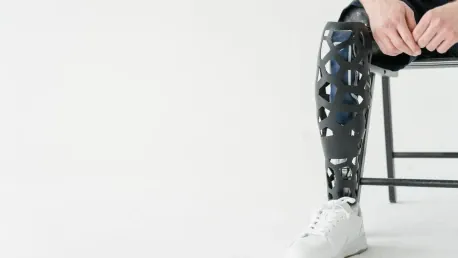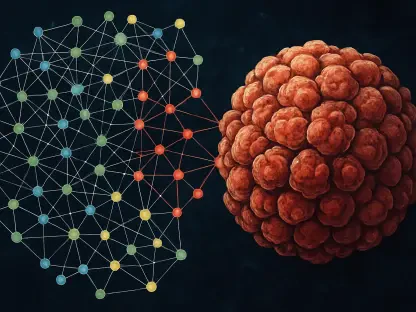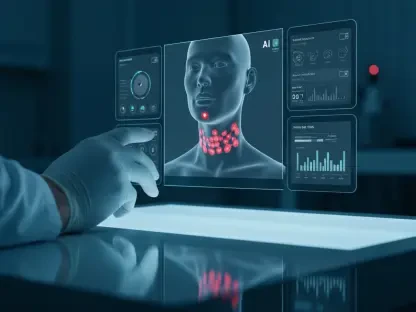Recent advancements in medical technologies have often led to breakthroughs that were once considered unattainable, and the field of orthopedic surgery is no exception. Researchers from Cincinnati Children’s Hospital and the University of Cincinnati (UC) have developed an innovative 3D-printed scaffold that shows significant promise in addressing the treatment of large osteochondral defects. These defects, especially those larger than 2.5 cm in diameter, present a substantial challenge for current medical treatments largely due to the avascular nature of articular cartilage, which limits its self-repair capabilities. Existing treatment methods, including the osteochondral autograft transfer system (OATS), often fall short, encountering problems related to unsatisfactory tissue remodeling, integration issues, and a decline in mechanical properties over time.
This novel 3D-printed scaffold ingeniously merges synthetic and biological materials, specifically incorporating decellularized human bone and cartilage tissue microspheres. These microspheres are designed to release proteins and growth factors essential for fostering the growth of new tissue, contributing significantly to the scaffold’s efficacy. The researchers utilized a patented 3D printing process enabling the creation of customized implants that perfectly match the exact size and shape of the patient’s osteochondral defects. In their recent study, they tested the efficacy of this scaffold by implanting it into pre-clinical models with distal femoral osteochondral defects, subsequently comparing the results to both a negative control group and OATS autografts.
Promising Results and Integration with Host Tissue
The outcomes of the study are incredibly promising, revealing that the biomimetic scaffold achieved progressive and spatially oriented osteochondral tissue regeneration. This regeneration was deemed comparable to the results achieved with OATS autografts, but with the added advantage of better integration with the host tissue. One notable aspect of the study was that the scaffold induced the expression of specific bone and cartilage genes crucial for tissue regeneration and long-term maintenance. The success in promoting gene expression indicates that this scaffold not only acts as a physical structure for tissue growth but also engages in active biochemical signaling to support new tissue formation.
Furthermore, the scaffold exhibited excellent integration with the host tissue, which is a critical factor in the success of any implant. Poor integration can lead to implant failure, mechanical instability, and ultimately, the need for additional surgeries. By fostering well-integrated tissue growth, this scaffold presents a potentially transformative approach to treating large osteochondral defects, which are typically challenging due to their size and the complex nature of cartilage and bone regeneration.
Future Implications and Continued Research
The impact of this research extends far beyond the immediate findings. The scaffold’s potential to transform treatment approaches for patients with significant osteochondral injuries, including children, teenagers, and young adults, is substantial. For these groups, who are at a heightened risk of progressing to early osteoarthritis due to untreated or inadequately treated defects, the scaffold offers a new avenue for effective intervention and long-term joint health. The success of the initial studies strongly supports ongoing investigations into the scaffold’s application for even larger defects and related orthopedic conditions, such as avascular necrosis of the femoral head.
Additionally, the successful implementation of this scaffold stands as a testament to the potential of combining synthetic and biological materials in medical implants. By leveraging the body’s natural biological processes in conjunction with advanced synthetic frameworks, researchers can develop more effective, durable, and biocompatible solutions. This approach marks a significant shift from traditional methods and opens new pathways for the treatment of other challenging orthopedic conditions. Therefore, the continued research and development of this scaffold hold immense promise for advancing the field of tissue engineering and regenerative medicine.
Collaboration and Future Directions
Recent advancements in medical technology have frequently led to breakthroughs once thought impossible, and orthopedic surgery is no exception. Researchers from Cincinnati Children’s Hospital and the University of Cincinnati (UC) have engineered an innovative 3D-printed scaffold showing great promise in treating large osteochondral defects. Defects larger than 2.5 cm in diameter pose a significant challenge due to the avascular nature of articular cartilage, which limits its ability to self-repair. Current treatments, like the osteochondral autograft transfer system (OATS), often fall short, facing issues with tissue remodeling, integration, and a decline in mechanical properties over time.
This novel scaffold cleverly combines synthetic and biological materials, incorporating decellularized human bone and cartilage tissue microspheres. These microspheres release proteins and growth factors crucial for new tissue growth, enhancing the scaffold’s effectiveness. The researchers used a patented 3D printing process to create custom implants that precisely match the patient’s osteochondral defect’s size and shape. In their recent study, they tested this scaffold in pre-clinical models with distal femoral osteochondral defects, then compared the results to both a negative control group and OATS autografts.









